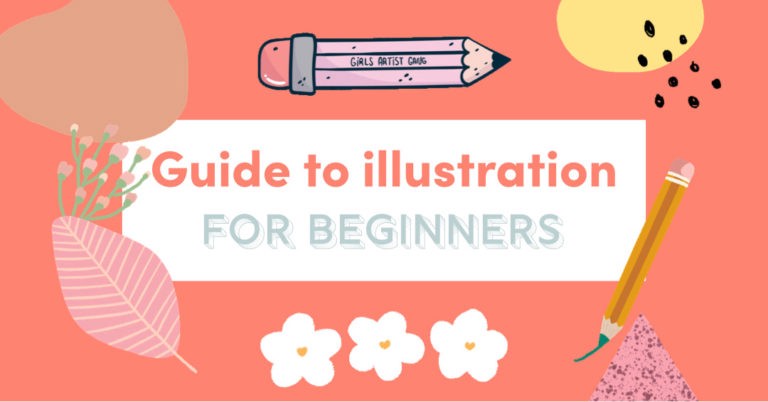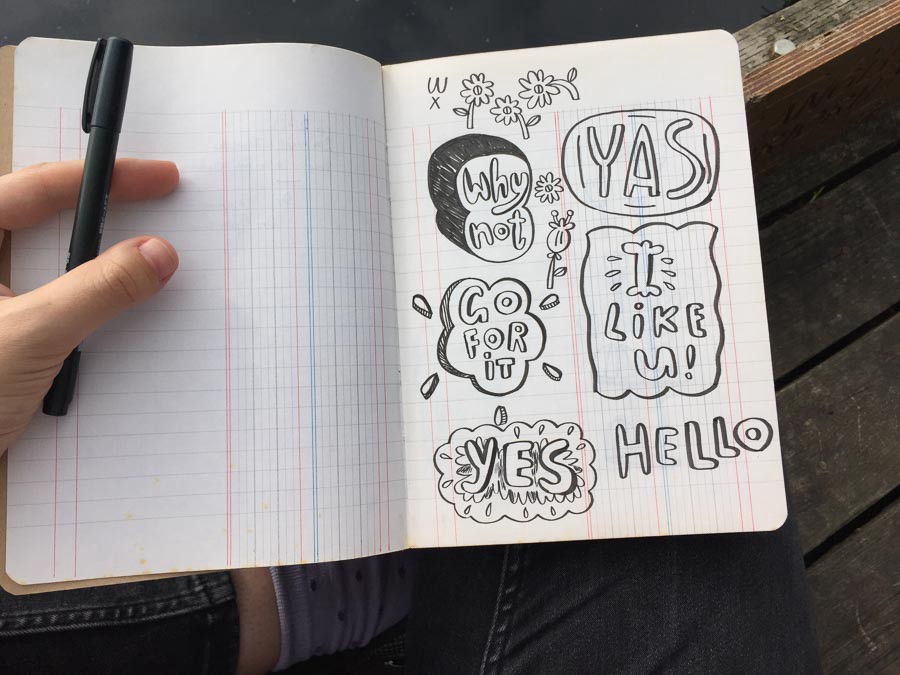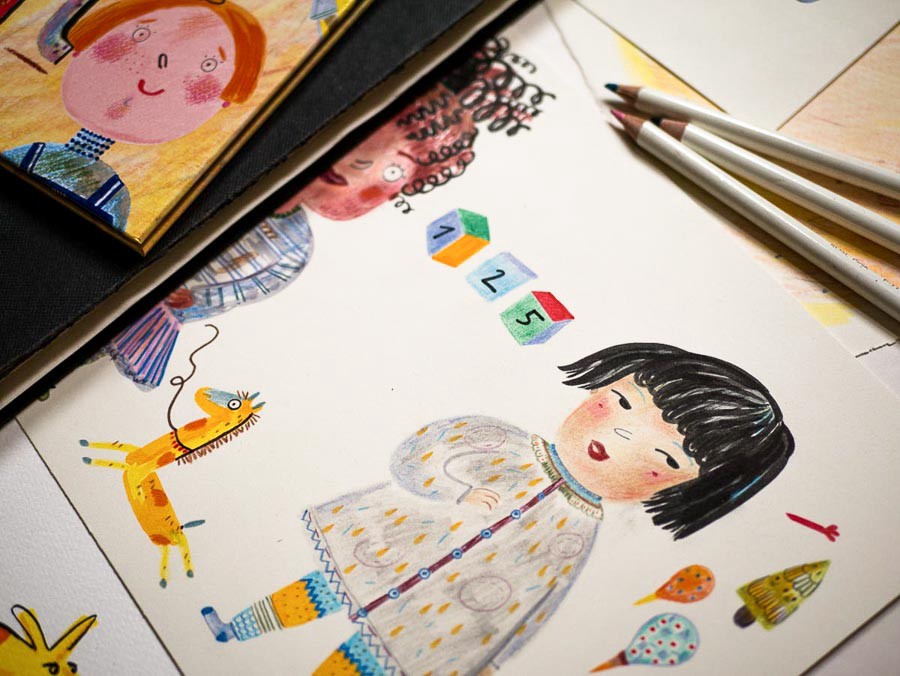Where do you start with illustration as an absolute beginner? Should you invest time in learning how to draw first, or should you start by mastering digital software? This was the question that my old friend from school asked me a few days ago.

Edited 08.07.2020
Being an illustrator is an attractive occupation for those who love to draw. It is creative and commercial with a prospect of having your work seen and admired by thousands of people.
However, to get to a stage of being commissioned and making a living from it takes commitment, perseverance and artistic skills. I believe that becoming an illustrator is not difficult, but you have to be smart about what you do.
From my experience, there are three main components to becoming successful at illustration:
- Confidence in your style
- Market awareness
- Self promotion
(and a bit of luck)
Tips for finding your visual style.
If you are an absolute beginner, then finding a way to express yourself visually will be the most important step in your practice.
Drawing is the most obvious way that illustrators use to express their ideas, so learning to draw will definitely be high on your agenda.
Check out these easy drawing exercises for beginners in this article.
How to kick start your drawing practice:
1. Get a sketchbook and use it to draw from life regularly ? in any way you can.
In the beginning, a pencil and a blank sheet of paper become two most terrifying things on earth, so you will need to take care of your mindset before you begin.
Read this article for a few psychological tips.
The aim here is not to become very good at drawing, although that might also inevitably happen, but to become comfortable with your own creative expression. For example, if your drawing is naive and loose, you might decide to embrace that as part of your style.
It doesn?t have to be realistic. Some people trained as classical painters and drawers struggle when it comes to illustration. That?s because contemporary illustration favours more expressive styles and fast turnaround.
2. Doodle, draw from reference (from photographs), or draw from your head ? do anything you can to get more confident with holding a pencil and telling a story.
When I was very young I used to make stick men comic books. I wasn?t very good at drawing then but wanted to tell stories. My other friend, who used to go to a ?proper? art school used to laugh and tell me that comic books couldn?t be made with stick men.
That comment stuck with me and took me a while to get over. But after years of design education, I learnt that in reality, visual communication can be expressed through many mediums, so there is no shame in using humble stick men to convey your story, or circles, or smudges, or lines.
3. Copy other people?s work (for educational purposes ? do not try to pass off other people?s work for your own).
Right now I am not a fan of copying. BUT! When I think back on my own learning curve, I have to admit that copying was helpful in the very beginning, when I didn?t have enough confidence in my own drawing abilities. When you have absolutely zero experience and skills copying is a great start.
If you are copying, try to use the same materials as the artist, and use the process as a tool to discover which art techniques you prefer. And remember: copying someone else?s style while not working on developing your own bears a danger of becoming a one-trick pony with no personal voice. You have been warned. Also, word of warning: do not try to pass other people?s work as your own.
Do read this blog post on finding your own personal style.
3. Explore other mediums
Or you might decide to abandon drawing altogether and use other mediums like photography, collage, vector art or puppet making. Check out the work of this illustrator who uses paper collage as her main medium.
Remember that contemporary illustration does not confine in drawn images only. Draw in your style, draw any way you can. If drawing does not come easily then experiment and look for other possibilities.
4. Stay motivated
Please note that this process of discovering your style will take time, and you might find it difficult to stay motivated on your own. There will be plenty of opportunities to procrastinate and abandon this project whatsoever, so it may be helpful to enlist your family and friends to support you.
Or, you can proclaim yourself as a buddying illustrator in a new Instagram account or even start a blog. Maybe you can look for Facebook groups or challenges and drawing marathons. This accountability from others will help you keep going when times get rough.
5. Use your personality
Your own personality plays a big part in creating your artist persona too. You are a person with certain interests and stories that shaped your character. Use that knowledge to form your style as an illustrator.
It?s important to capitalise on things you are personally attracted to. It may be cute floral patterns or historical events, but start with researching what you naturally enjoy and create illustrations on that theme.

Should I learn how to draw or master digital software first?
As to learning the software, I would recommend learning the basics of drawing first. Once you are comfortable with your drawing, it is pretty straightforward to then learn how to make it digital.
You might save yourself time by exploring more accessible tools for image making first. Also, many contemporary illustrators work with minimal or no computer use, so lack of software knowledge shouldn?t be something to deter you.
However, if you are a digital native and reading this makes you feel like you would be better off starting straight on the computer, then, by all means, go for it. Drawing on an iPad is an excellent way to start drawing, much easier than learning Photoshop in the desktop.

Where to find inspiration.
Now that you proclaimed yourself a creative person, you should start to think like one. One of the best takeaways from my design degree was learning to think like an artist.
1. Begin collecting colours, textures and references into some sort of scrapbook or a digital collection.
2. Start a digital Pinterest board and collect images that you like.
3. Get obsessed with weird things that other people rarely think about, such as certain species of beetles or 1960s holiday resorts.
4. Go to libraries and art exhibitions and keep your eyes peeled.
5. Look at works of illustrators and artists from other creative fields, such as films, books, music, ballet, etc.
6. Notice new things in stuff you see on a daily basis, as it can also become your inspiration.
You are going to need some content to feed your mind to be able to produce exciting imagery.
Creating structure with briefs and self-initiated projects
Illustrators are so called because they illustrate something: a mood, a piece of text, a concept, a theme, a person, etc.
So to develop your illustration practice, you will need to have a theme or a project to give you structure.
In the industry creative projects are called briefs. It?s important to learn to work to a brief if you want to become a commercial illustrator.
I have put a list of where to find real industry briefs here. They are unpaid but they provide a great practice to develop your portfolio.
Alternatively, work on self-initiated projects.
Find yourself something to illustrate for. Maybe it will be a story that you made up yourself, or just a general topic like ?cats? or ?magic?, or a book that you have always loved, a song, or a poem.
Maybe you will draw all your colleagues as succulents. Whatever it is, start by giving yourself a challenge.
Download a free list of illustration prompts here.
?Should I learn drawing properly or should I start by practising illustration every day??
This depends on the style of illustration that you want to do. If you are interested in doing very detailed photorealistic drawings, then you would benefit from traditional academic drawing skills. Think life drawings and old fashioned fine art lessons about perspective and tone.
However, if you are interested in contemporary illustration, you will notice a variety of styles, most being sketchy and expressive. If that?s the style you like, then it?s not necessary to learn to draw ?properly?. Instead, you need to learn to draw with personality. Your clients will come to you because they look for a ?human touch?, an emotional way of expressing a subject. Otherwise, they could just use a photograph.
Your job is to discover what style of illustration you want to do. Is it sleek digital vectors? Is it expressive line drawings? Or is it colourful and friendly picture book art?
I believe that the main thing you should aim for is being comfortable with your own drawings. You should be at a stage when you know you can easily draw anything in your own style to take commissions. You need to develop your own way of drawing that you can happily sustain. And to do that you need to practice regularly. There are definitely some tricks that will help you improve your drawings. I wrote about some contemporary drawing exercises in this blog post.
You can also improve drawing skills relatively easily by:
- Going to local life drawing classes
Some life drawing classes just put the model in the front and let you get on with it. Ideally, you want a class where the teacher will introduce you to a new art material or give you some tips. Life drawing is not essential to become an illustrator but it?s a good practice if you want to draw people.
- Joining a local sketch crawl
There is a big community of artists who get together and sketch around the city. You can find a local group in most places around the globe. Going out drawing in a group is great because you can learn tips from each other and it?s easier to draw outside with other people (you don?t get too many weird looks from the public)
- Check out local museums and galleries for free drawing classes
If you live in a big city then you are very fortunate to be near museums that might offer drawing activities and guided walks. Drawing in museums is very convenient because it?s quiet and you will not get disturbed. Also, you can find inspiration that is unique.
?Should I go to college or should I just do short courses??
I am a firm believer that you don?t need a degree in illustration to work as an illustrator. It seems strange coming from a person who did a BA in illustration, but looking back the main benefits of going to uni were:
- the social aspect of being around other creatives
- broadening general knowledge and awareness about design history
Both of these are beneficial but not essential. So if you have the budget and time to spare, then go for it! I particularly recommend Falmouth University, who even offer an online illustration MA and also Anglia Ruskin Children?s Book Illustration MA course which is a springboard for many successful illustrators in the U.K.
Saying that I think that you can become a successful illustrator by doing specialised short courses. Most of them you can simply do online. Here is a list of courses that I recommend:
1. ?Make art that sells?
Lisa Rogers is an illustration agent who offers many niche courses on different styles of illustration. All her courses are driven by industry experience and geared towards working as a professional illustrator.
2. Princes Royal drawing school in London offers some great online and in-person drawing courses
I particularly recommend comics and graphic novels course by Emily Haworth-Booth.
3. Domestika
This website has a good selection of technical illustration lessons.
4. Skillshare
I really enjoyed this class about iPad drawing by Lisk Feng.
5. Chelsea online and offline short courses
UAL is a leading art & design university in the U.K. I did their Chelsea book illustration course, which is also offered online now.
I hope that these ideas will be helpful for you when you are starting out with illustration.


